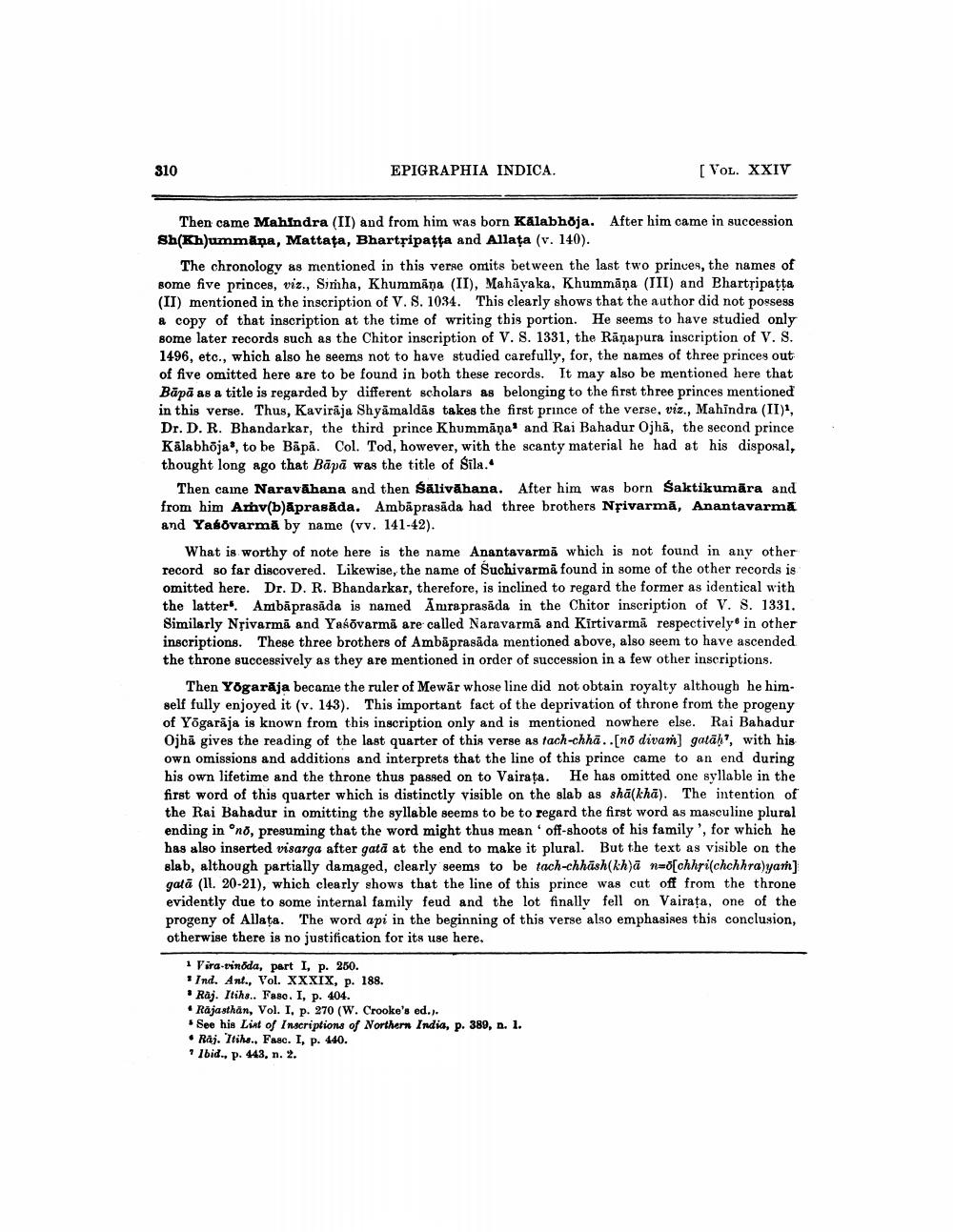________________
310
EPIGRAPHIA INDICA.
[Vol. XXIV
Then came Mahindra (II) and from him was born Kalabhðja. After him came in succession Sh(Kh)ummāpa, Mattata, Bhartripatta and Allata (v. 140).
The chronology as mentioned in this verse omits between the last two princes, the names of some five princes, viz., Simha, Khummāna (II), Mahāyaka, Khummāna (III) and Bhartsipatta (II) mentioned in the inscription of V. S. 1034. This clearly shows that the author did not possess a copy of that inscription at the time of writing this portion. He seems to have studied only some later records such as the Chitor inscription of V. S. 1331, the Rānapura inscription of V. S. 1496, etc., which also he seems not to have studied carefully, for, the names of three princes out of five omitted here are to be found in both these records. It may also be mentioned here that Bāpā as a title is regarded by different scholars as belonging to the first three princes mentioned in this verse. Thus, Kavirāja Shyamaldās takes the first prince of the verse, viz., Mahindra (II), Dr. D. R. Bhandarkar, the third prince Khummāņa' and Rai Bahadur Ojhā, the second prince Kālabhöja, to be Bäpă. Col. Tod, however, with the scanty material he had at his disposal, thought long ago that Bāpā was the title of Sila.
Then came Naravāhana and then Salivāhana. After him was born Śaktikumāra and from him Amhv(b)āprasada. Ambāprasāda had three brothers Nfivarmā, Anantavarma and Yasovarmā by name (vv. 141-42).
What is worthy of note here is the name Anantavarmā which is not found in any other record so far discovered. Likewise, the name of Suchivarmā found in some of the other records is omitted here. Dr. D. R. Bhandarkar, therefore, is inclined to regard the former as identical with the latter". Ambāprasāda is named Amraprasāda in the Chitor inscription of V. S. 1331. Similarly Nțivarmi and Yaśõvarmă are called Naravarmā and Kirtivarmā respectively in other inscriptions. These three brothers of Ambāprasāda mentioned above, also seem to have ascended the throne successively as they are mentioned in order of succession in a few other inscriptions.
Then Yogarāja became the ruler of Mewar whose line did not obtain royalty although he him. self fully enjoyed it (v. 143). This important fact of the deprivation of throne from the progeny of Yögarāja is known from this inscription only and is mentioned nowhere else. Rai Bahadur Ojhà gives the reading of the last quarter of this verse as tach-chha..[no divam) gatäh', with his own omissions and additions and interprets that the line of this prince came to an end during his own lifetime and the throne thus passed on to Vairata. He has omitted one syllable in the first word of this quarter which is distinctly visible on the slab as shā(khā). The intention of the Rai Bahadur in omitting the syllable seems to be to regard the first word as masculine plural ending in ono, presuming that the word might thus mean off-shoots of his family', for which he has also inserted visarga after gatā at the end to make it plural. But the text as visible on the slab, although partially damaged, clearly seems to be tach-chhāsh(kh)ā n=o[chhri(chchhra)yam) gatā (IL. 20-21), which clearly shows that the line of this prince was cut off from the throne evidently due to some internal family feud and the lot finally fell on Vairata, one of the progeny of Allata. The word api in the beginning of this verse also emphasises this conclusion, otherwise there is no justification for its use here.
1 Vira-vinoda, part I, p. 250. ? Ind. Ant., Vol. XXXIX, p. 188. . Raj. Itihs.. Faso. I, p. 404. • Rajasthan, Vol. I, p. 270 (W. Crooke's ed.). . See his Lint of Inscriptions of Northern India, p. 389. n. 1. • Raj.Itiha.. Fasc. I, p. 440. ? Ibid., p. 443, n. 2.




